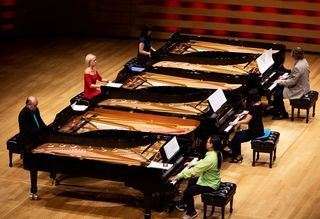|
Back
Pianistic exuberance on display Toronto
Koerner Hall
10/12/2018 -
John Cage: The Beatles, 1962-70
Alexina Louie: “The Ringing Earth” and “Homage” from Afterimages
Juliet Palmer: Five*
Witold Lutoslawski: Variations on a Theme of Paganini
André Ristic: Variations on a Theme by A. Vivaldi
Steve Reich: Six Pianos
Stephanie Chua, Radka Hanakova, Russell Hartenberger, Midori Koga, Gregory Oh, Jamie Parker (piano), Ryan Scott (piano/percussion*) 
(© Claire Harvie)
Soundstreams opened its 36th season with a typically unique program featuring six pianos played in various configuration by seven pianists.
In keeping with the magical number six, there were six works on the program, starting off with John Cage’s The Beatles 1962-70, commissioned in 1989. Since it is a Cage work, it comes a no surprise that it can be performed by various ensembles (so why not six pianos), and that it is definitely NOT a pastiche of Beatle tunes. The nine-minute piece contains fragments of tunes which can be used freely by whoever is playing. The disjointed bits zoom or float past very quickly, discouraging any effort to “name that tune”. I recognized a total of two. One player used a referee’s whistle at one point. A very deadpan joke.
We next heard two of the three movements from Alexina Louie’s Afterimages, composed in 1981 for two pianos, this time played by Midori Koga and Gregory Oh. There are chime-like sounds in “The Ringing Earth” and to me both pieces evoked watery depths.
Koga and Oh were joined by Ryan Scott on percussion for Juliet Palmer’s piece Five from 2008, which uses a song “Hand in My Pocket” by Alanis Morrissette. All three players also vocalize (using microphones). As in John Cage’s Beatles work, there is fragmentation of the original source. The composer states that the Morrissette song had wormed its way into her ear; I can’t say the Palmer piece did this, but I am probably in the wrong demographic.
Another work for two pianos (Stephanie Chua and Jamie Parker this time) was Witold Lutoslawski’s Variations on a Theme of Paganini composed in Poland in 1941 for performance by Lutoslawski and fellow composer Andrzej Panufnik. It is a variation on the famous 24th caprice that Brahms used in his well-known solo piano work. The piece displays jazz influence; it gets downright giddy and has an exuberant ending. The composer used the term “polyharmony” to describe the relationship between the two piano parts – i.e., they don’t play in unison, but it is still tonal. It comes as a bit of a surprise that someone was having musical fun in German-occupied Poland.
For the first half of the program, the pianos were arranged in three pairs, but for the second half they formed a tighter cluster (see photo above). André Ristic’s Variations on a Theme by A. Vivaldi, receiving its world premiere, tuned out to be the hit of the evening. The original Vivaldi work was a concerto for four violins and orchestra (part of his L’estro armonico), subsequently reworked by JS Bach for four harpsichords and orchestra). Ristic’s piece begins with all six pianists playing in stately unison, but things develop dynamically, with oscillating sweeps of sound and lyrical interludes. The effect of the multi-layered sounds is very sensuous. The complexity of the work is such that I would think it might well use a conductor; instead, Gregory Oh gave a few minimal cues. The 14-minute work is too short. I would love to hear it again, but this will have to wait until someone manages once again to get six pianos on a stage.
The grand finale was Steve Reich’s Six Pianos, the piece that inspired this program. For this work, one of the pianists was Russell Hartenberger, who was a member of Steve Reich’s ensemble when the piece was created in the early 70s (and who later became Dean of Music at the University of Toronto). Once again Gregory Oh gave minimal cues. The 21-minute work is very fast; three pianists play different notes to the same rhythmic pattern, then others join in; the texture is always thick (and loud) but subtle rhythmic shifts occur throughout. The most striking thing about the work is the startling effect of silence once it has ended; its length and intensity (“onslaught” is an apt word) is such that by its end it seems as if it has always been sounding. Some members of the audience felt knocked askew while others were jubilant.
During the interval, Soundstream’s founder and director, Lawrence Cherney, received a lifetime achievement award from the Toronto Musicians’ Association. In his 36 years at the helm of this venturesome organization, with some 170 commissions to its credit, plus a brilliantly selected array of exchanges with terrific international ensembles, showcasing Canadian composers and performers far and wide, he is certainly due such recognition. One such example upcoming: this program will tour Asia in 2020.
Michael Johnson
|